Guidance notes on manual handling operations
Appendix 1 - Manual Handling Risk Assessment - Detailed Assessment Guidelines Filter
Appendix 2 - Manual Handling Operations - Assessment of Risk
Appendix 3 - Manual Handling of Loads Risk Assessment Form
Appendix 4 - Effect of Twisting and Frequency on HSE Guidelines for Manual Handling Operations
Appendix 5 - Reduction in Individual Handling Capacity as the Hands Move Away from the Trunk
Manual handling is the transporting or supporting of a load by one or more workers. This may include lifting, lowering, pushing, pulling, carrying and moving loads whether by hand or bodily force.
The risks to health from manual handling falls within three main categories:
-
Musculoskeletal injuries (i.e. those concerning the muscular or skeletal system of the body) occurring when the effort required to handle the load is beyond the capability of the handler;
-
Injuries caused by the load falling onto or trapping part of the handler or someone nearby;
-
Injuries caused by the handler falling, perhaps against the load or other object.
Musculoskeletal injuries maybe either acute, i.e. as an immediate effect from the manual handling operation, or may be chronic i.e. as a result from continual manual handling operations over a period of time.
Manual handling is subject to the legislation entitled ' Manual Handling Operations Regulations 1992'. The purpose of the legislation is to reduce the risk of injury from manual handling.
To comply with the regulations, employers must follow five basic steps:
-
Identify all manual handling operations undertaken by their employees;
-
Make an initial appraisal of all operations to determine if there is a significant risk of injury to employees;
-
Avoid manual handling tasks where reasonably practicable, e.g. by substituting with a sack barrow, trolley or forklift truck etc.;
-
Make a full assessment of unavoidable risky operations taking into account the load, task, the working environment and the individual capability of the workers;
-
Remove or reduce the risk of injury by implementing control measures designed to eliminate or minimise the risks of injury to the lowest level so far as reasonably practicable.
In the context of the Regulations, compliance with the term 'reasonably practicable' would be satisfied where it can be shown that the cost of any further preventative measures would be grossly disproportionate to the further benefits gained from their introduction.
2. ADVICE FOR HEADS OF SCHOOLS / UNITS / RESIDENCES
Individual Schools/Units/Residences must comply with the requirements of the relevant Regulations.
Where a manual handling operation cannot be avoided, an initial appraisal should be made as to the nature and likelihood of injury. Numerical guidelines which may be used in straightforward cases are provided in Appendix 1. These numbers are only guidelines and may be exceeded if an assessment shows it is appropriate to do so having regard to the employer's duty to avoid or reduce risk of injury where this is reasonably practicable.
NOTE: Any manual handling operation should not exceed twice the guideline figures.
If the frequency of the manual handling operations is high and/or there is a significant amount of twisting during the manual handling operation, then the guideline figures should be appropriately adjusted (see Appendix 4). The guidelines should also be modified if the load is held from the body (relevant modifications can be seen in Appendix 5).
Where initial appraisal indicates a possibility of injury, a more detailed assessment must be made. In most cases such assessments can be made by a member of staff who has undergone appropriate training and has a sound knowledge of the work activity.
Guidance on performing assessments is given in the HSE booklet entitled 'Guidance on Regulations, Manual Handling Operations Regulations 1992'. A copy of this document is available for viewing at Environmental, Health and Safety Services. It is recommended that Schools/Units/Residences that regularly carry out manual handling operations obtain a copy of this document.
To comply with the legal requirements placed upon the University, manual handling risk assessments should be 'Suitable and Sufficient'. For most operations this requirement may be complied with by performing a 'Generic' risk assessment which draws together common threads from a range of broadly similar operations.
Risk assessments identify, in broad terms, the foreseeable problems which are likely to arise during manual handling operations and the measures needed to deal with the risks. It should be appreciated that this is a legal requirement placed on employers and is, therefore, quite different from the, often rapid, everyday judgements which supervisors and staff will have to make when dealing with manual handling operations.
Assessment Procedure
The assessment procedure should be in line with that given in HSE guidance (see Appendix 1 and Appendix 2). If a full risk assessment is required, then this should be recorded using the University standard form (see Appendix 3).
If the assessment indicates there is a foreseeable risk of injury from the manual handling operations, then you should first consider avoiding the need for the operations in question.
If you cannot avoid the manual handling operation, then you should perform an appropriate assessment. The assessment should include control measures to minimise the risk.
Factors which should be taken into account when performing the risk assessment include:
-
The task;
-
The load;
-
The working environment;
-
The capacity of the handler;
-
Other relevant factors.
Based on the risks associated with the manual handling operation, a hierarchy of control measures should be considered. These are:
-
Split into smaller lighter loads;
-
Use more than one person to lift the load;
-
Use a mechanical aid to lift the load e.g. sack barrow or fork lift truck.
No member of staff should attempt to lift or move a load if they are in any doubt as to their capability to do so without risk to their health and safety.
Training courses for assessors and employees whose work involves a significant proportion of routine manual handling are organised by Environmental, Health and Safety Services.
Health problems arising from manual handling should be brought to the attention of the University Occupational Health Adviser (Tel: 2752).
7. GENERAL GUIDANCE ON HANDLING LOADS
The Health and Safety Executive states that manual handling at work is the cause of over 36% of all accidents reported to them each year. The most common injuries include a strain (a wrench or tear of the muscle) or a sprain (a wrench or tear of a ligament) to the back or to a limb but manual handling operations can cause more serious injuries e.g. fracture of the bone.
Since any employee within a variety of workplaces (e.g. workshops, laboratories, residences, offices, catering and grounds) may at sometime need to move a heavy or awkward load, the following guidance is given on the best way to avoid injury.
Recognition of Risks
There is a risk of back injury if, during tasks that you routinely carry out, there is frequent or prolonged:
-
Forward bending;
-
Sideways bending;
-
Twisting;
-
Holding a load from the trunk of the body.
If you think that routine manual handling carried out during the course of your work may put you at risk, contact your School/Unit Safety Co-ordinator.
Guidance on Moving Loads
1.
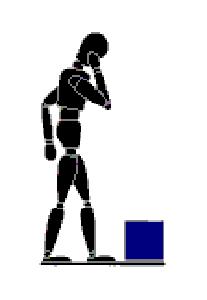
Stop and Think
Plan the lift. Where is the load going to be placed? Use appropriate handling aids if possible. Do you need help with the load ? Remove obstructions such as discarded wrapping materials. If you are carrying the load over a distance, you should ensure the route is clear of any obstacles or blockages before you begin the lift. For a long lift - such as floor to shoulder height - consider resting the load mid-way on a table or bench to change grip.
2.

Place the Feet.
Have the feet apart, giving a balanced and stable base for lifting (tight skirts and unsuitable footwear make this difficult). Have the leading leg as far forward as is comfortable.
3.

Adopt a Good Posture.
Bend the knees so that the hands when grasping the load are as nearly level with the waist as possible. Do not kneel or overflex the knees. Keep the back straight, maintaining its natural curve (tucking in the chin while gripping the load helps). Lean forward a little over the load if necessary to get a good grip. Keep the shoulders level and facing in the same direction as the hips.
4.

Get a Firm Grip.
Try to keep the arms within the boundary formed by the legs. The optimum position and nature of the grip depends on the circumstances and individual preference, but it should be secure. A hook grip is less fatiguing than keeping the fingers straight. If it is necessary to vary the grip as the lift proceeds, do this as smoothly as possible.
5.
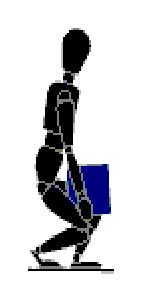
Lift Load Smoothly.
Carry out the lifting motion smoothly, raising the chin as the lift begins, keeping control of the load.
6.
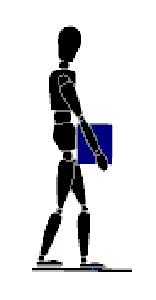
Move the Feet.
Do not twist the trunk when turning to the side.
Keep Close to Load
Keep the load close to the trunk for as long as possible. Keep the heaviest side of the load next to the trunk. If a close approach to the load is not possible, try sliding it towards you before attempting to lift it.
7.
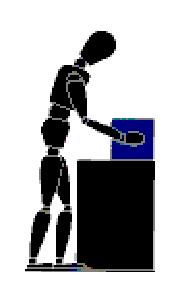
Put Down, then adjust.
If precise positioning of the load is necessary, put it down first, then slide it into the desired position.
It is recommended that if the handler is lifting a load to shoulder height or above, then, if practicable, an intermediate resting place for the load should be used to allow the handler to change hand grip.
Note: Items should not be stored above head height unless there is a suitable means of access. Items should never be stacked on shelving above head height.
Guidance on Pushing and Pulling Loads
When pushing and pulling a load, you should ensure you have a secure footing and the hands are applied to the load between the shoulder and waist wherever practicable. A further option , where other safety considerations allow, is to push the load with the handler's back using the leg muscles to exert the force.
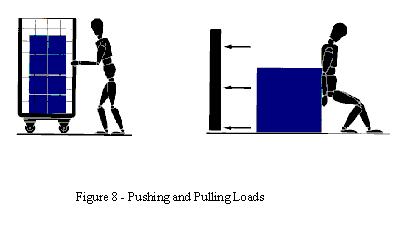
Manual Handling Risk Assessment - Detailed Assessment Guidelines Filter
(Produced by the Health and Safety Executive)
Introduction
The manual handling regulations set no specific requirements such as weight limits. Instead, they focus on the needs of the individual and set out a hierarchy of measures for safety during manual handling operations:
-
Avoid hazardous manual handling operations so far as reasonably practicable;
-
Make a suitable and sufficient assessment of any hazardous manual handling operations that cannot be avoided; and
-
Reduce the risk of injury from those operations so far as reasonably practicable.
Risk Assessment
Where manual handling operations cannot be avoided, the employer has a responsibility to make a suitable and sufficient assessment of the risks to health. This assessment must take into account the range of relevant factors listed in the HSE book entitled ' Manual Handling Operations Regulations 1992 - Guidance on Regulations'. A detailed assessment of every manual handling operation, however, could be a major undertaking and might involve wasted effort. Many manual handling operations, for example lifting a tea cup, will involve negligible risk. To help identify situations where a more detailed risk assessment is necessary, the Health and Safety Executive (HSE) has developed a filter to screen out straightforward cases.
The filter is based on a set of numerical guidelines developed from data published in scientific literature and on practical experience of assessing risks from manual handling. They are pragmatic, tried and tested; they are not based on precise scientific formulae. The intention is to set out an approximate boundary within which the load is unlikely to create a risk of injury sufficient to warrant a detailed assessment.
The application of the guidelines will provide a reasonable level of protection to around 95% of working men and women. However, the guidelines should not be regarded as safe weight limits for lifting. There is no threshold below which manual handling operations may be regarded as 'safe'. Even operations lying within the boundary mapped out by the guidelines should be avoided or made less demanding wherever it is reasonably practicable to do so.
It is important to remember that the purpose of the guidelines is to avoid wasting time and effort. The use of the filter will only be worthwhile, therefore, where the relevance of the guideline figures can be determined quickly, say, within 10 minutes. If it is not clear from the outset that this can be done, it is better to opt immediately for the more detailed risk assessment.
Guidelines for Lifting and Lowering
The guidelines for lifting and lowering operations assume that the load is easy to grasp with both hands and that the operation takes place in reasonable working conditions with the handler in a stable body position. They take into consideration the vertical and horizontal positions of the hands as they move the load during the handling operation, as well as the height and reach of the individual handler. For example if the load is held at arms length or the hands pas above shoulder height, the capability to lift is reduced significantly (see Appendix 5).
The basic guideline figures for identifying when manual handling lifting and lowering operations may not need a detailed risk assessment are set out in figure 9 below. If the handler's hands enter more than one of the box zones during the operation, the smallest weight figures apply. It is important to remember, however, that the transition from one box zone to another is not abrupt; an intermediate figure may be chosen where the handler's hands are close to a boundary. Where lifting or lowering with the hands beyond the box zones is unavoidable, a more detailed assessment should always be made.

-
Each box in the above diagram represents a different lifting zone e.g from the ground or at knuckle level. The guideline weights for lifting from the relevant zone by males is given as the top number in each box and the lower number is the figure for females.
Figure 9 - Guideline Weights for Lifting and Lowering for Men and Women.
These basic guideline figures for lifting and lowering are for relatively infrequent operations - up to 30 operations per hour. The guideline figures should be reduced if the operation is repeated more often (see Appendix 4). As a rough guide, the figures should be reduced by 30% where the operation is repeated once or twice per minute, by 50% where the operation is repeated around 5-8 times per minute and by 80% where the operation is repeated more than about 12 times per minute.
Even if the above conditions are satisfied, a more detailed risk assessment should be made where:
-
The worker does not control the pace of the work;
-
Pauses for rest are inadequate or there is no change of activity which provides an opportunity to use different muscles;
-
The handler must support the load for any length of time.
Guidelines for Carrying
Similar guideline figures apply to carrying operations where the load is held against the body and is carried no further than about 10 metres without resting. If the load is carried over a longer distance without resting or the hands are below knuckle height then a more detailed risk assessment should be made.
Where the load can be carried securely on the shoulder without first having to be lifted (as for example when unloading sacks from a lorry) the guideline figures can be applied to carrying distances in excess of 10 metres.
Guidelines for Pushing and Pulling
For pushing and pulling operations (whether the load is slid, rolled or supported on wheels) the guideline figures assume the force is applied with the hands between the knuckle and shoulder height. The guideline figure for starting or stopping a load is a force of 25 Kg (i.e. about 250 Newtons) for men and about 16 Kg (i.e. about 160 Newtons) for women. The guideline figure for keeping the load in motion is a force of about 10 Kg ( i.e. about 100 Newtons) for men and about 7 Kg ( i.e. about 70 Newtons) for women.
There is no specific limit to the distance over which the load is pushed or pulled provided there is adequate opportunities for rest or recovery.
Guidlines for Handling While Seated
The basic guideline figure for handling operations carried out while seated, shown in the figure10 below, is 5 Kg for men and 3 Kg for women. These guidelines only apply when the hands are within the boxed zone indicated. If handling beyond the box zone is unavoidable, a more detailed risk assessment should be made.


-
The guideline weights for lifting by males is given as the top number in the box and the lower number is the figure for females.
Figure 10 - Handling While Seated
Twisting
In many cases, manual handling operations will involve some twisting and this will increase the risk of injury. Where the handling task involves twisting and turning, therefore, a detailed risk assessment should normally be made. However, if the operation is relatively infrequent and there are no other posture problems then the filter can be used. In such cases, the basic guideline figures shown should be reduced by if the handler twists to the side during the operation (see Appendix 4 for the modified guideline numbers). As a rough guide, the figures should be reduced by about 10 % where the handler twists through 45o and by about 20 % if the handler twists through 90o.
Remember: The use of these guidelines does not affect the employer's duty to avoid or reduce the risk of injury where this is reasonably practicable. The guideline figures, therefore, should not be regarded as weight limits for 'safe' lifting. They are an aid to highlight where detailed risk assessments are most needed. Where doubt remains, a more detailed risk assessment should always be made. Even for the minority of fit, well trained individuals working under favourable conditions, operations which exceed the guideline figures by more than a factor of two may represent a serious risk of injury. Such operations should come under very close scrutiny.
Manual handling Operations - Assessment of Risk
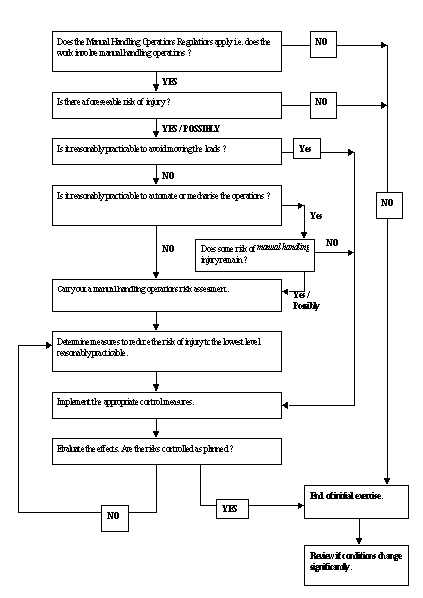
(A copy of this form can be downloaded - Manual Handling of Loads - Risk Assessment (Word, 215 KB))
Manual Handling of Loads - Risk Assessment Form
Section A - Preliminary:
| Job Description
. . Factors Beyond the Limits of the Guidlines . . |
Is an Assessment Needed?
(i.e. is there a potential risk for injury, and are the factors beyond the limits of the guidelines?)
YES / NO |
If 'YES', continue. If 'NO', the assessment need go no further.
| Operations covered by this assessment:
(Detailed description) . Location : . Personnel Involved: . Date of Assessment: |
Diagrams(and other relevant information)
. . . . . .
|
Section B
| Questions to consider |
If YES, tick as appropriate:
Low Medium High |
Problems occurring from the task. (Make rough notes in this column in preparation for the possible remedial action to be taken).
|
Possible Remedial Action
(Possible changes to be made to system/task, load, workplace/space, environment. Communication that is needed).
|
The Tasks:
|
.
. . . . . . |
.
. . . . . . |
.
. . . . . . |
The Loads: are they
|
.
. . .
|
.
. . .
|
.
. . .
|
The Working Environment:
|
.
. . . . |
.
. . . . |
.
. . . . |
Individual Capability - Does the job:
|
.
. . . . |
.
. . . . |
.
. . . . |
| Other factors | . | . | . |
Section C - Overall Assessment of the Risk of Injury ? HIGH / MEDIUM / LOW
Section D - Remedial Action
| Remedial steps that should be taken, in order of priority:
1.
2.
3.
4.
5.
|
|
Date by which action should be taken: ............................................................................................. |
|
Date for reassessment ..................................................................................................................... |
|
Assessors Name: ................................................... Signature ....................................................... |
Effect of Twisting and Frequency on HSE Guidelines for Manual Handling Operations
(A copy of this diagram can be downloaded as a Microsoft Word 97 document - Manual handling operations - effect of twisting and frequency (RTF, 1,133 KB))
| Twisting
Frequency |
0 o
<30/hour |
0 o
<2/min |
0 o
<12/min |
0 o
>12/min |
 |
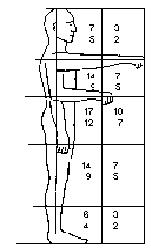 |
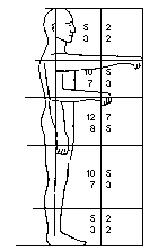 |
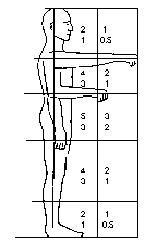 |
|
| Twisting
Frequency |
45o
<30/hour |
45o
<2/min |
45o
<12/min |
45o
>12/min |
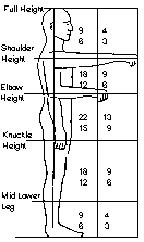 |
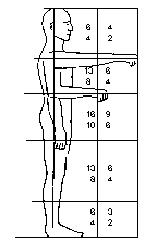 |
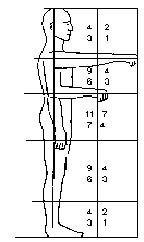 |
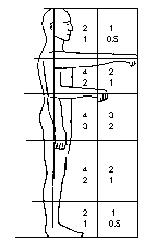 |
|
| Twisting
Frequency |
90o
<30/hour |
90o
<2/min |
90o
<12/min |
90o
>12/min |
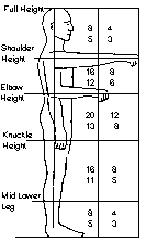 |
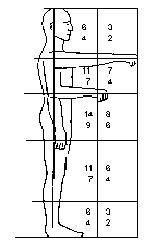 |
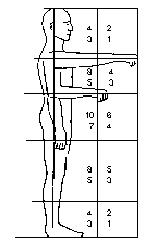 |
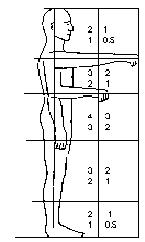 |
Manual handling operations - effect of twisting and frequency (RTF, 1,133 KB)
Reduction in Individual handling capacity as the Hands Move Away from the Trunk
